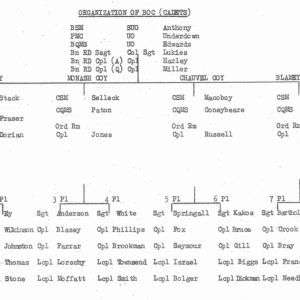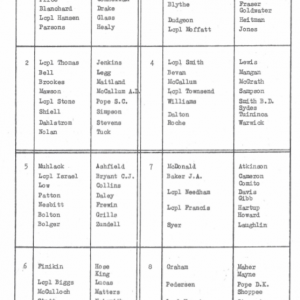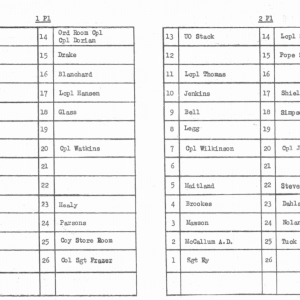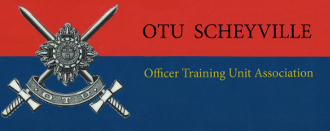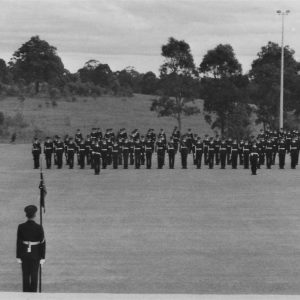As a part of the giant OTU Jigsaw, there is a need to set up a sheet for each class that shows the structure of each class, which varied in accordance with the number of Cadets in training, and also includes the ‘Fathers & Sons’. These details all help in providing an accurate figure of how many Cadets commenced the course to produce 1,699 NS and 104 Air Cadet Graduates, along with 68 OCS (Scheyville) Wing graduates (and ten CMF Officers).
With deferments taken into account, the average age of Nashos in the 1965 – 72 era was just over 20 years. However, with many of those selected for training at OTU having had deferments to complete degrees, diplomas and trades etc, the average age of Scheyvillians was more like 21 years. The middle year of this era was 1969, so with the average age of the 1969 cohort being 21 that group now has an average age of 72. Recent Scheyvillian newsletters have contained 3-4 Vales and this number is likely to increase each year as we age. So, before we all end in a Vale in The Scheyvillian, it is time for action!
It has been recognised that with the introduction of National Service in 1965 the standards within the Army rose. For a start, the average age of Nasho was nearly three years older than the Regular Army Recruits. Three years older with three years more life experience! As described by Corporal Mick Rainey in Gary McKay and Graeme Nicholls book ‘Jungle Tracks’ (The RAAC in Vietnam) when talking about the Nashos ‘The biggest thing for me out of Vietnam, was how good they were. I struck this when I came back from Vietnam to the Armoured Centre to be an Instructor. Some of these guys were 22 or 23, quite mature. The National Serviceman was much easier to teach. If you had a young Regular soldier at seventeen, he had shit for brains.’ When OTU commenced the age of officers entering training at OTU was generally higher than those entering RMC Duntroon, although probably slightly younger than those entering OCS Portsea.
Overall, the Army benefitted greatly from National Service with these older Recruits and more highly (civilian) qualified Junior Officers. In Vietnam, Nasho and Air Cadet officers performed to the highest standard and many OTU Non-Graduates (DNGs) were given rank ahead of their ARA counterparts. The flow-on effect was that thousands of soldiers and hundreds of Scheyvillians ‘signed on’ for careers in the ARA and many others ‘signed on’ for careers as part-time soldiers with the CMF (later known as the Army Reserve).
It is important that the history of OTU Scheyville, both from the National Service/Air Cadet perspective, and the OCS (S) Wing perspective, is well documented and preserved at the Australian Army Museum, Duntroon (formerly the RMC Museum), the repository of all Australian Army officer training history. Roger Donnelley’s first book, The Scheyville Experience (2001) is a good starting point for this history, and his new book (currently being written) will expand on that base.
However, there is so much more information that needs to be recorded. As the years pass a database of postings for Scheyvillians is being assembled, and lists such as those with service in Vietnam, Air Cadets and Nasho Pilots and Graduates, Repeats and Non-graduates have been added to the OTU website.
The last project is the assembly of the ‘Structure and Fathers & Sons’ for each of the classes. There were 30 NS/Air Cadet Classes, and with the three Terms for the OCS (S) era, there is a total of thirty-three Terms. With information now becoming available a total of eighteen of the thirty-three Terms have been completed. These structures list the postings of the Battalion of Officer Cadets for BHQ, CHQ, Pl Staff and ‘Fathers & Sons’. This information is available in the General Instruction issued to each Cadet on March In. The structures vary from two companies of three platoons, three companies of three platoons, four companies of two platoons and so on down to the final class, OCS (S) 1/73 with a structure of just one platoon at graduation. Some Cadets did not have a ‘Son’, while others had up to four ‘Sons’.
To complete this task the Editor, The Scheyvillian, is looking for details of the Structure, the ‘Father and Sons’ allocation and room allocations which are obtained in the General Instruction for each March In.
He is particularly looking for the General Instructions for the following classes:
2/66 (May), 2/67 (May), 3/67 (Jul), 4/67 (Oct), 2/68 (May), 4/68 (Oct),
1/69 (Feb), 2/69 (May), 3/69 (Jul), 2/70 (May), 4/71 (Oct), 1/72 (Feb),
2/72 (May) and OCS (S) O1/73 March In (Jan) and Senior (Apr) Terms.
From the General Instruction, the important information is:
The list of March Ins for the incoming Junior Class (including any Repeats),
The list of Senior Class Cadets continuing the course,
The BOC Structure (BHQ/CHQs/Pl Sgts/Pl Cpls),
Fathers and Sons, and Room Allocations.
In addition, the association does not have March In photographs for:
1/66 (C Class), 2/67 (all Classes), 3/67 (B and C? Class), 4/67 (all Classes),
2/70 (B Class), 1/71 (all Classes), OCS (S) O2/72 and O1/73.
These photographs will also assist in the compilation of the list of Cadets who commenced the course.
If you can help with the missing General Instructions or March In photographs, please contact the Editor at
nkaleckie@optusnet.com.au or 0400 573 802
